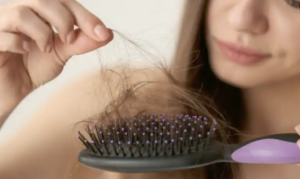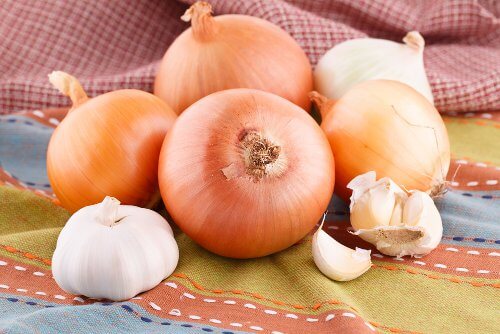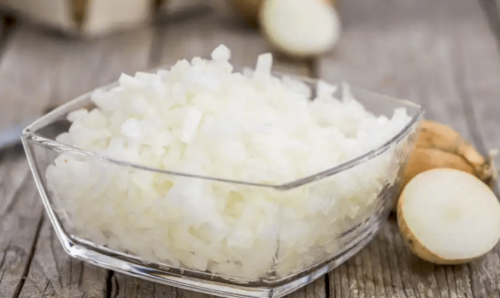4 Onion Treatments to Reduce Hair Loss


Reviewed and approved by the doctor Karla Henríquez
Did you know that onion treatments can help you control excessive hair loss. This hair disorders is common and affects both men and women.
Although the most advisable thing to do in these cases is consult a medical professional. You can complement their treatment with a few simple natural ones as long as they OK it.
Today we’re going to share 4 onion treatments. Check them out and try them if you’re afflicted by this condition. Continue reading!
Onion treatments to reduce hair loss
While it’s normal to lose between 50 and 100 strands of hair every day, some of us lose way too much. The problem is it isn’t always easy to fix and the mane begins to look weak and loses volume over time.
Fortunately, there are all-natural treatments with properties to promote hair growth and reverse the loss. This study from the Polytechnic University of Baghdad in Iraq states that the use of onion juice could be good for hair regeneration.
1. Onion and garlic

Combining onion juice and garlic cloves creates an all-round treatment to strengthen the roots and to prevent excessive hair loss.
Ingredients
- 4 raw onions
- 6 cloves of garlic
- ½ glass of water (100 ml.)
Method
- First, peel the onions and garlic, and put them in a food processor and blend them with half a glass of water
- Once you have a smooth juice, strain the liquid to remove any solids
- Part your hair into various sections and rub the juice all over your scalp
- Allow it to work for 30 minutes and then, rinse with your normal shampoo
- Repeat until you notice progress
Read about 3 ways to encourage good hair growth
2. Onion and oil
Next, this treatment is recommended for anyone who suffers from a dry, flaky scalp, as well as hair loss.
Ingredients
- 2 raw onions
- 2 tbsp. of coconut oil (30 g.)
- 1 tbsp. of olive oil (16 g.)
Method
- Firstly, peel the onions and blend them in a food processor, along with the coconut oil and olive oil
- Once you’re left with a thick paste, part your hair into various sections and rub the paste into your roots
- Cover your hair with a shower cap and allow it to work for 30 or 40 minutes
- Rinse out with your normal shampoo, and repeat until you notice a difference
3. Onion and honey
Ingredients
- 2 raw onions
- 3 tbsp. of bee honey (75 g.)
Method
- First, chop the raw onion into small pieces and blend it in a food processor along with the honey until you get a wet paste
- Then, rub it into your entire scalp and hair, and cover with a shower cap for 40 minutes
- Rinse as usual and use the treatment two or three times a week
4. Onion and shampoo treatments

By adding a few bits of onion to your normal shampoo, you can also obtain good results to reduce hair loss. The onion’s properties are easily absorbed into the scalp.
Ingredients
- A raw onion
- 1 bottle of herbal shampoo
Method
- First, chop the onion into small cubes and then put them into the bottle of herbal shampoo
- Leave the onion to soak in the shampoo for a week before using it to wash your hair
- Then, rub the product into the scalp well in order to help absorption and promote circulation
- Allow it to work for 20 minutes and then, rinse
- Apply the treatment twice a week
We recommend you read: How to stop hair loss with coconut water and lemon
Remember to consult a specialist first
As we have mentioned above, it’s essential to first consult a doctor before using any type of natural treatments on your scalp. It’s important to ensure you’re not allergic to any of the ingredients involved.
Likewise, stop the treatment if you notice eczema, itching or stinging of the scalp after application. Your hair will look healthy and beautiful if, in addition to taking care of it externally, maintain a balanced diet and have regular checkups with qualified professionals.
All cited sources were thoroughly reviewed by our team to ensure their quality, reliability, currency, and validity. The bibliography of this article was considered reliable and of academic or scientific accuracy.
- Harfmann, K. L., & Bechtel, M. A. (2015). Hair loss in women. Clinical Obstetrics and Gynecology. https://doi.org/10.1097/GRF.0000000000000081
- Stollery, N. (2013). Hair loss. The Practitioner. https://doi.org/10.1046/j.1365-2230.2002.01104.x
- DeLoughery, T. G. (2017). Iron Deficiency Anemia. Medical Clinics of North America. https://doi.org/10.1016/j.mcna.2016.09.004
- Griffiths, G., Trueman, L., Crowther, T., Thomas, B., & Smith, B. (2002). Onions – A global benefit to health. Phytotherapy Research. https://doi.org/10.1002/ptr.1222
- Arnault, I., & Auger, J. (2006). Seleno-compounds in garlic and onion. Journal of Chromatography A. https://doi.org/10.1016/j.chroma.2006.01.036
- S. Bisen, P., & Emerald, M. (2016). Nutritional and Therapeutic Potential of Garlic and Onion (Allium sp.). Current Nutrition & Food Science. https://doi.org/10.2174/1573401312666160608121954
- Sharquie, K. E., & Al-Obaidi, H. K. (2002). Onion juice (Allium cepa L.), a new topical treatment for alopecia areata. Journal of Dermatology. https://doi.org/10.1111/j.1346-8138.2002.tb00277.x
- Villalobos, J. R. V., Pacheco, D. P., & Ramos, M. C. C. (2008). Las especies del género” Allium” con interés medicinal en Extremadura. Medicina naturista, 2(1), 3-8. https://scholar.google.es/scholar?hl=es&as_sdt=0%2C5&q=cebolla+para+combatir+alopecia&btnG=#d=gs_qabs&u=%23p%3DwQs72bKQPs4J
This text is provided for informational purposes only and does not replace consultation with a professional. If in doubt, consult your specialist.








